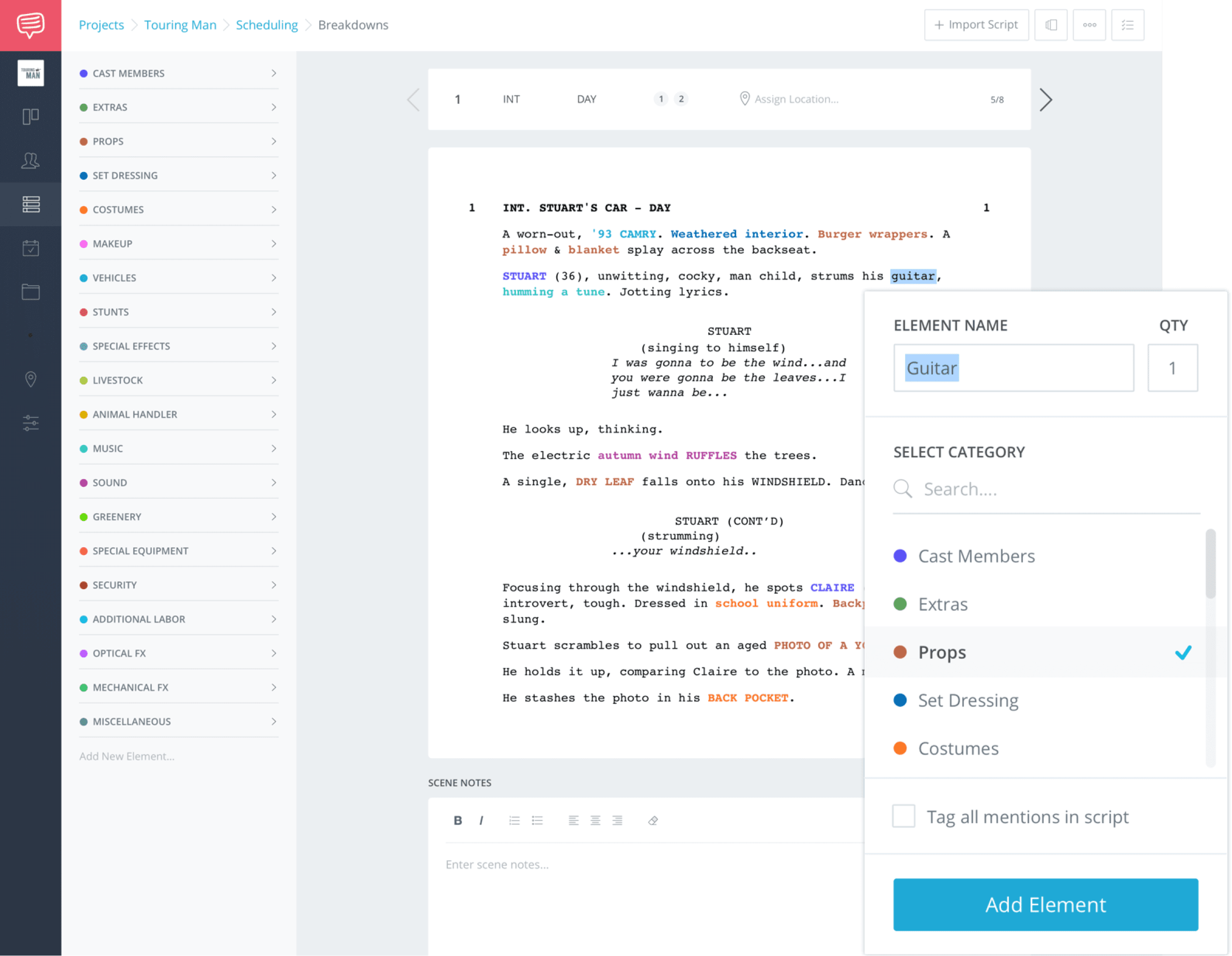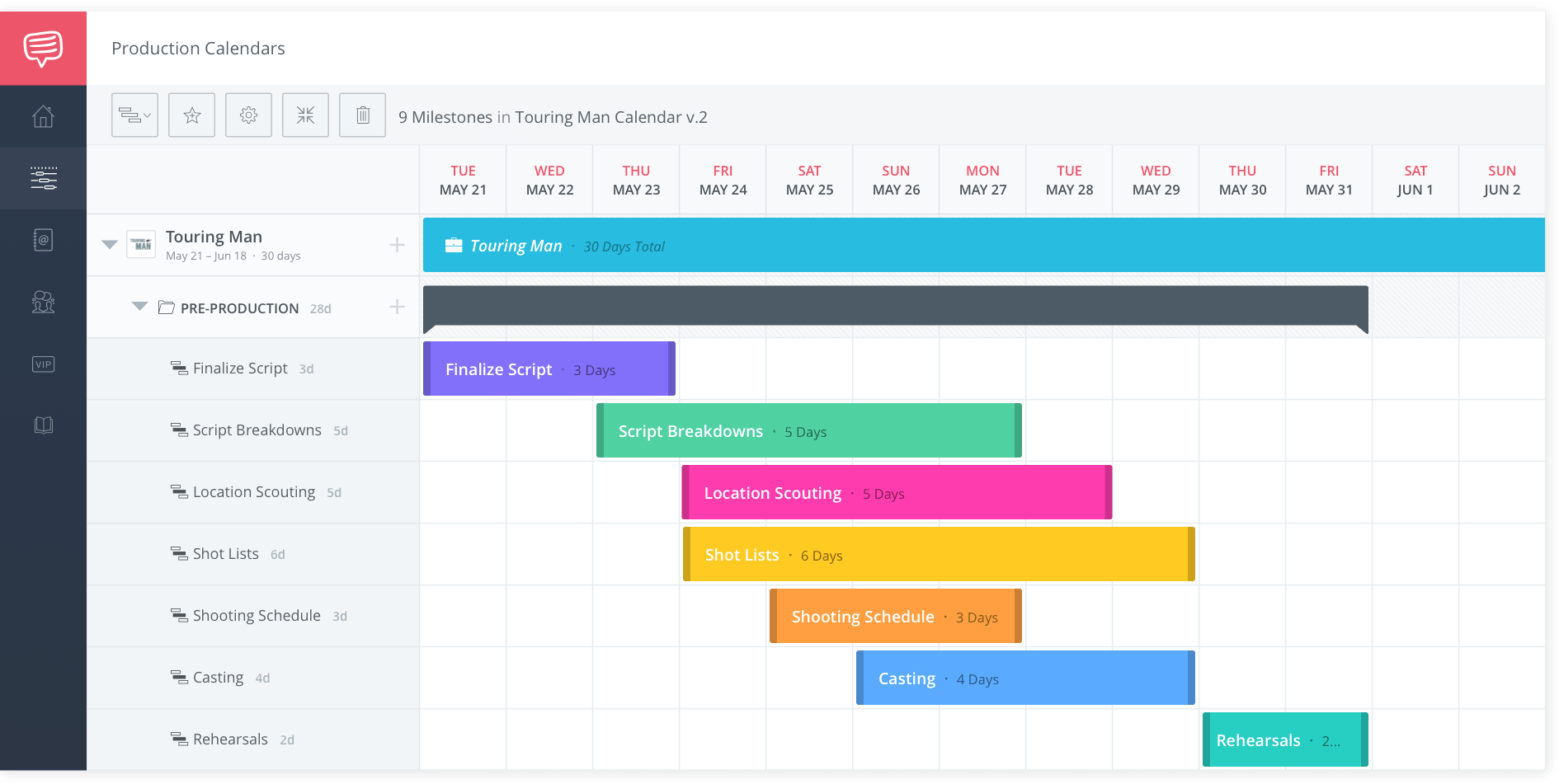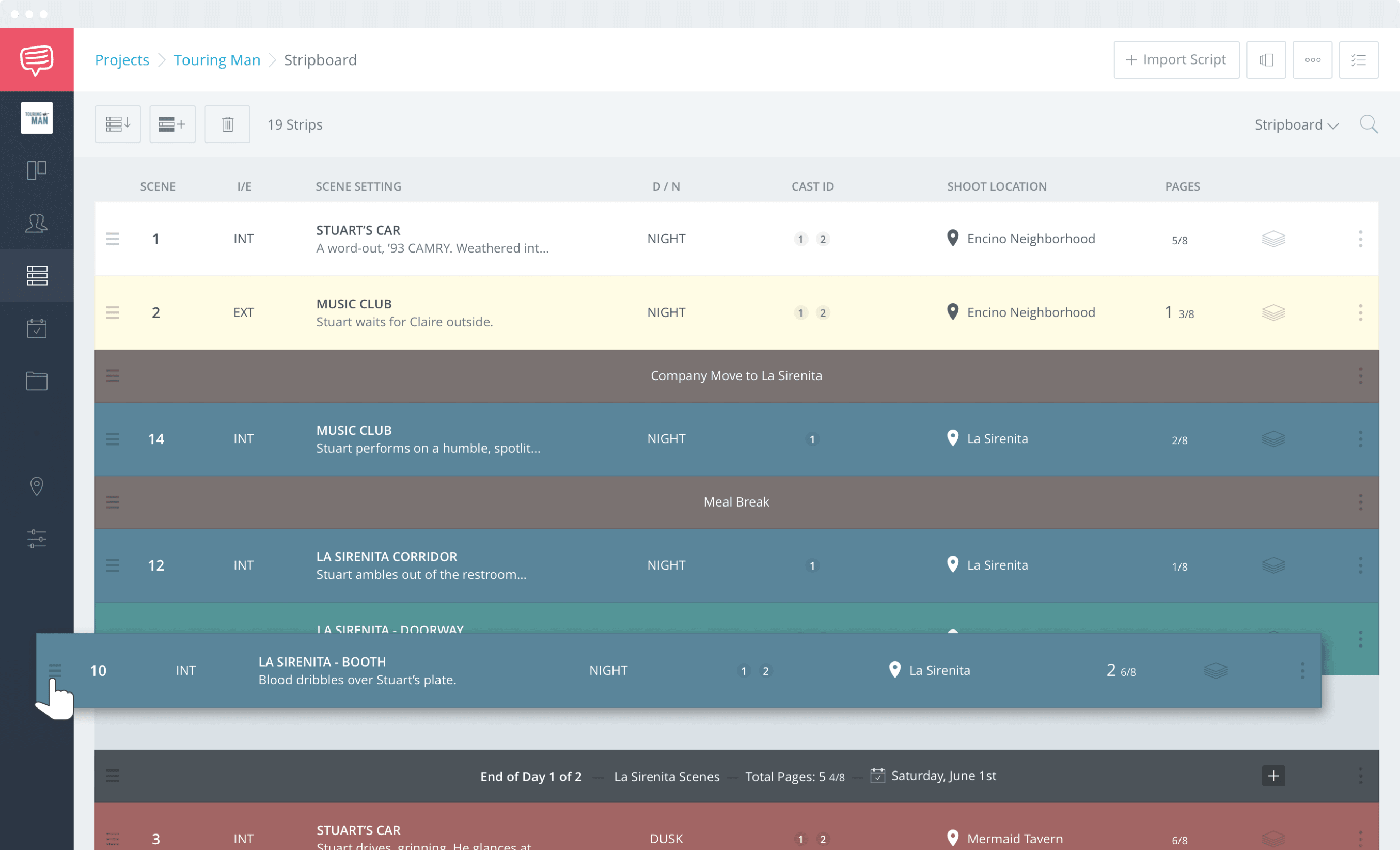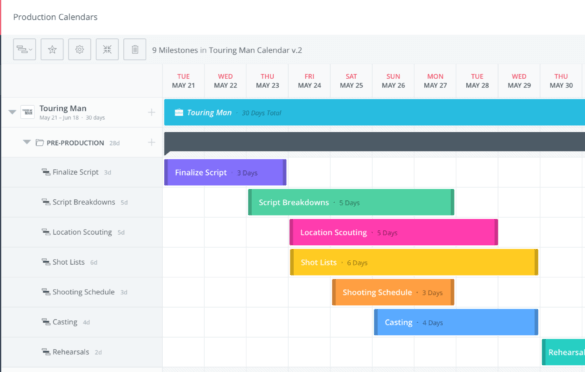Production has a million pieces and if you’re not careful, dates and segments will fall through the cracks. That’s why producers on feature films and explainer videos use a production calendar.
Working from a screenplay, your video production calendar covers pre production, production, and post production. But how does one begin to schedule and what makes up each part?
Table of Contents
Everything you need to know about Production Calendars!
The Ultimate Guide to an Effective Production Calendar
First, create a preliminary script breakdown

StudioBinder Script Breakdown Sheet Software Tagging Elements for Film Scheduling Software
Once a script has been green-lit for film production, the first step is carefully breaking down your script into element categories (breakdown sheets).
You’ll want a list for your actors, your extras, your props, and locations, to name a few of the many production elements. It’s a pain to fill out breakdown sheets by hand, but if you’re using film production management software like StudioBinder, you can easily tag your script and let the software bucket your elements into their proper lists.
While you will already have an idea of the departments you need to contact in the pre production process, your first script breakdown will give you a sense of scale as well as a preliminary budget.
For instance, you may already know you need makeup, but a script breakdown could reveal that you need to show a flesh wound, meaning a higher budget and different professionals.
After completing a breakdown, you’re ready to tackle pre production.
1
Pre-production
The pre-pro process
The pre-production process
What is the pre-production process?
Pre-production is that idealistic phase when you determine how all the elements are going to be gathered together so that each department can do its job come video production. Here are the key areas that should be on any producer checklist.

The pre-production process
1.1 THE PRE-PRODUCTION PROCESS
Finalize Script
As is the case with any brilliant screenplay, revisions will happen. As changes come through, be sure to note them with your entire video production team and that many copies are safely stored in the cloud.
It’s important to note that script alterations will also change your budget. Your script won’t truly be finalized until you head into production and figure out the associated costs. Make sure you’re using software that can register changes, so if the script changes, you won’t lose your breakdown progress.
1.2 THE PRE-PRODUCTION PROCESS
Finalize Script Breakdowns
Getting deja vu? Once the shooting script is locked, it’s time to complete another script breakdown. Like we said, using software that can hold changes greatly comes in handy.
Here you want to make sure that everything is finalized. If you broke down your script at first into broad categories like “makeup,” now you can go even further (“monster makeup” and “regular makeup”).
Whatever labels you use for your own production needs, specificity can only help you. You’ll want to have breakdowns for locations and every production department to cover the main bases.
1.3 THE PRE-PRODUCTION PROCESS
Finalize Budget
You should always have an idea of your film budget. When you make your preliminary breakdown, there’s usually a budget attached to that as well.
Your finalized budget will change throughout the pre production process as you learn how much it will cost for stunts and effects and all the other production elements. A long production calendar can tack on additional dollars to an existing budget.
1.4 THE PRE-PRODUCTION PROCESS
Location Scout
Location scouting is that part of the pre production process where you’ll send out members of your team to secure the places you’ll shoot.
Have a location scout checklist handy before you send your team out and makes sure there’s always communication with the location manager. It’s also at this stage that you’ll determine what can be shot on a soundstage and what sets need to be built.
Just make sure you get all the approved signatures before you snag a location.
1.5 THE PRE-PRODUCTION PROCESS
Storyboard
You’ll need to hire a storyboard artists (and some concept artists couldn’t hurt either) to storyboard out difficult to intricate sequences.
If you’re working on an explainer video or commercial, you may want to consider storyboarding the entire thing. With lots of storyboard software out there, it's easier than ever.
In StudioBinder, you can create storyboards directly from your shot list and auto-generate shareable slideshows. And it's free to start.
1.6 THE PRE-PRODUCTION PROCESS
Create Shot Lists
This is the time where your DP and director get together and talk about how they want to shoot everything. It’s a matter of going scene by scene and adding shots.
Your shot lists will determine what kind of cameras you’ll need for the shoot, as well as, the crew you’ll need. You can find the the best free shot list template here.
1.7 THE PRE-PRODUCTION PROCESS
Make a Shooting Schedule
Your shooting schedule will break your script into days of a shoot. Taking into account the budget, the talent and crew’s busy schedules, this is easily one of the hardest sections of your production calendar.
Your shooting schedule will determine how long the production part of your schedule will last, so figuring out a strategy is extremely important. In StudioBinder, you can easily rearrange your scenes to draft up multiple schedules on the fly.

Film Production Stripboard - Shooting Schedule - Stripboard Example
1.8 THE PRE-PRODUCTION PROCESS
Hire Crew
From key grips to production assistants to composers, you need to hire a crew for your project to come to life. Designers, production departments, and distributors for later are all in this bucket.
Networking sites like ProductionBeast can be great places to find new hires, if your director and creatives don’t already have people in mind. By storing your contacts' info in StudioBinder, you can create lists that autogenerate on call sheets.
1.9 THE PRE-PRODUCTION PROCESS
Secure Rentals
Do you need an IMAX camera? Six? Okay, Christopher Nolan.
At this stage in your process, you want to a lot time for your production coordinator to rent out not only equipment for the actual shoot, but also rentals needed for the cast.
If you’re shooting on location, this would include transportation, as well as, hotel amenities. And don’t forget about the craft service tables and catering.
1.10 THE PRE-PRODUCTION PROCESS
Start Casting
Working with casting directors, it’s time to attach names (big or small) to your project. This process can take weeks, not matter what your time scale is. Make sure you get everyone’s information from main characters to background actors.
A free casting sheet template can take some of the pressure off.
1.11 THE PRE-PRODUCTION PROCESS
Hold a Table Read & Rehearse
Before production begins, it’s often a good time to assemble the cast and hear the script read aloud.
It can give the director an idea of what the damned thing will sound like and how to play up dynamics between the cast. Rehearsal is the place to work out all the details so you won't waste time on the actual shoot day.
2
production
stages of production
THE Stages of production
What are the stages of production?
After you go through your pre production checklist, you’re ready to start production on your film. Unlike pre production, production is more straightforward & encompasses three parts. Here's our movie checklist.

The Ultimate Guide to an Effective Production Calendar - Production Process
2.1 THE STAGES OF PRODUCTION
Start Shooting
While picks ups cover minor details, a pick-up means an entire scene needs to be reshot. Maybe the daily footage didn’t go over well, or maybe it’s congruous with the rest of the picture.
Either way, re shoots can be costly. Building them into your production calendar as early as possible allows you to get the best deals on your talent, because they’re already expecting to come back to set. It also allows you to keep sets so that way they won’t have to be rebuilt.
2.2 THE STAGES OF PRODUCTION
Knock Out Pick-ups
Pick ups or pick up shots are minor footage you can grab after principal photography has wrapped. They can be inserts, establishing shots, or minor grabs.
2.3 THE STAGES OF PRODUCTION
Begin Reshoots
While picks-ups cover minor details, a reshoot means an entire scene needs to be reshot. Maybe the daily footage didn’t go over well, or maybe it’s congruous with the rest of the picture.
Either way, reshoots can be costly. Building them into your production calendar as early as possible allows you to get the best deals on your talent, because they’re already expecting to come back to set.
If you don't plan for reshoots throughout the production process, sets may be accidentally discarded, raising the budget.
3
Post-Production
post-pro process
THE post-production process
What is the Post-Production Process?
Post production is where you assemble all of the raw footage into one cohesive project. From scoring to editing, here are the major milestones on any producers' checklist.

The Ultimate Guide to an Effective Production Calendar - Post-Production Process
3.1 THE POST-PRODUCTION PROCESS
Cut a 1st Edit
Once you’ve compiled all the raw footage, an editor will throw it with the director into a first edit. This will be screened for advertisers to get an idea of how to market the film as well as executives and producers attached.
If you’re a video agency, this is what you’d send to your clients to see if they had any notes and to show that you don’t spend all of your time on Reddit.
3.2 THE POST-PRODUCTION PROCESS
Add in VFX
Visual effects, or optical effects, are the touch ups that computer wizards put in your film. While more prevalent in Hollywood blockbusters, everything from corporate videos to short films use VFX to add in a car here or there or alter an actor's performance.
3.3 THE POST-PRODUCTION PROCESS
Color Correct
If you’re a photographer or agency, this stage will likely occur more quickly than the other aspects of post production.
While the colors of the film are established when you create mood boards in pre production, there’s always some fun to be had with color in post.
3.4 THE POST-PRODUCTION PROCESS
Add Scoring & Sound
While your composer is hired early on, the actual scoring of the film won’t usually occur until this stage, with most filmmakers choosing to use temp music for their first edits. This is where you’d pay for the rights to a catchy song for your video.
Sound effects too are added by a foley artist at this point and any hard to hear lines of dialogue would be re-recorded by talent.
It’s important to note that if you’re working on an animated project, that the voice recordings would be recorded early on as would music for a music video.
3.5 THE POST-PRODUCTION PROCESS
Prep Your EPK
Known as an electronic press kit, an EPK is the tool you’ll use to market your film to festivals and distributors. You’ll need plenty of production stills, as well as, short inspirational snippets from your producers and creatives.
An EPK template is a great place to start when preparing your marketing strategy. As you begin to think about distribution, you’ll need an EPK handy.
3.6 THE POST-PRODUCTION PROCESS
Make 2nd Edit
Once more production elements, like score and sound effects come together, it’s time to create a 2nd edit of the project. While there’s no set number of edits required for a project, it’s important to note there are way more than one!
3.7 THE POST-PRODUCTION PROCESS
Cut a Final Edit
Once everything has been added into the project, and the clients and execs are happy with it, then it’s time to produce a final edit. More of a deadline than a set process, it’s when you can head into distribution and leave the production process behind with ease.
Up Next
Send out your production calendar and revise
Are you still with us?
By now you’ll have a preliminary production calendar mapped out. Send it out to your production heads, producers, clients, and other important people for their feedback.
And they will have feedback.
Having a production calendar as early as possible in the production process keeps every cog in motion, working together. By using film management software like StudioBinder, you can easily create and store production calendars, synced up with your shooting schedule and department heads.
How do you start your production calendars? Let us know in the comments.
